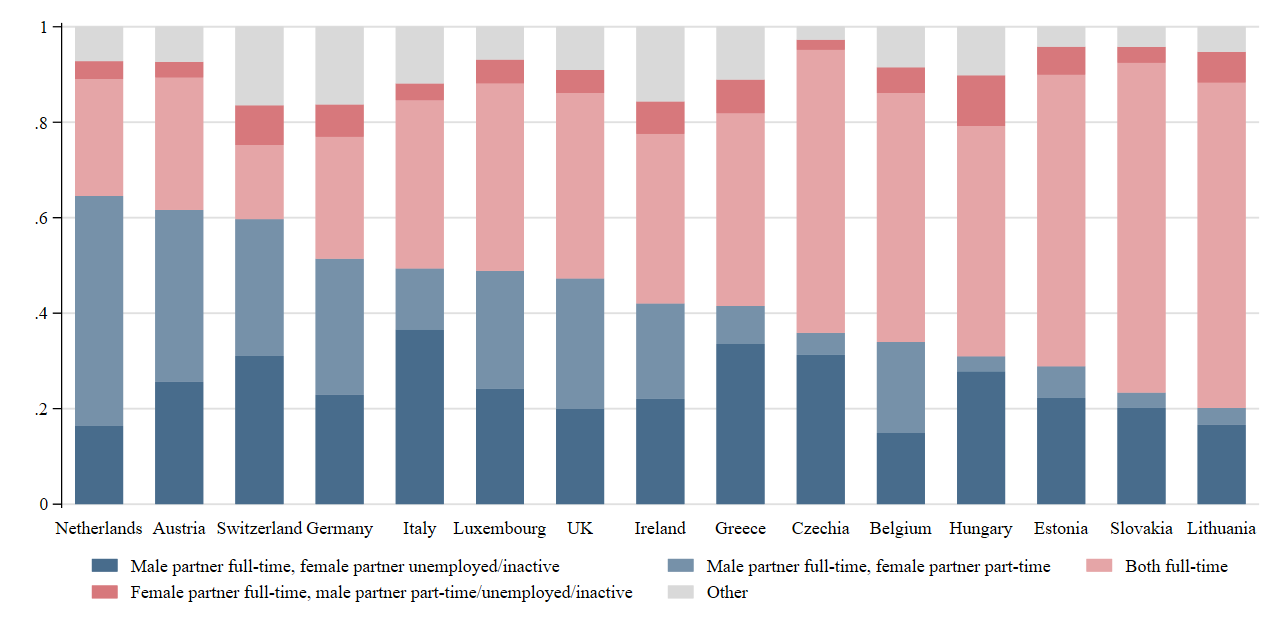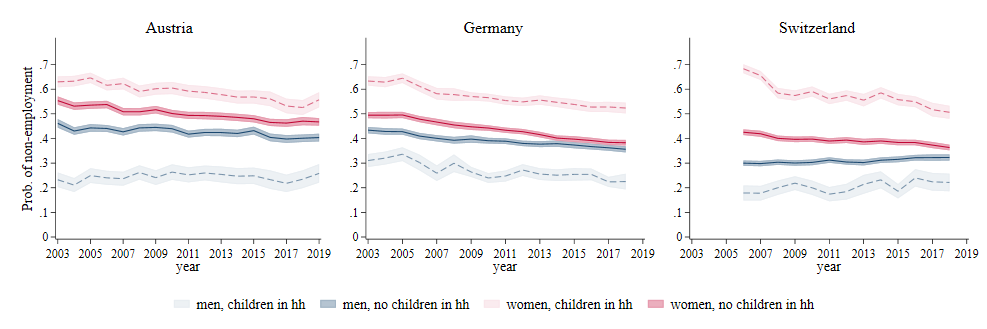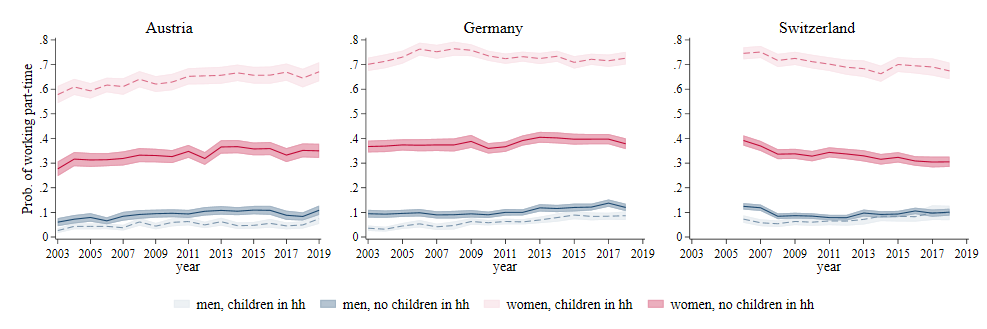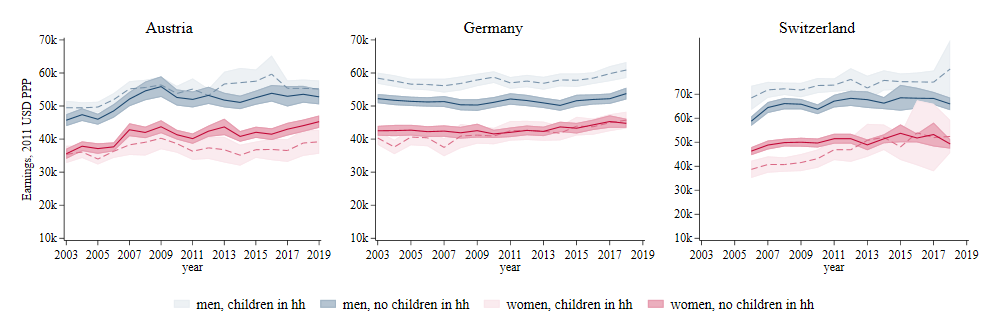Issue, No.20 (December 2021)
So close, yet so far: gender gaps in earnings in Austria, Germany and Switzerland
Gender differences in earnings remain at the core of inequality debate in Europe and elsewhere, and little has changed despite the vast evidence on the disadvantage women have in the labour market compared to men. There are many reasons why earnings gaps arise and persist. One of them is the so called “ideal worker” culture, where non-work related responsibilities are frowned upon and considered a threat to productivity (Haas and Hwang, 2018), leading to women’s underrepresentation in leadership positions. A related problem is the gender segregation across employment sectors, which leaves women concentrated in lower paid roles, particularly after childbirth. In fact, the literature acknowledges this phenomenon as ‘motherhood penalty’ (Budig and England, 2001) and also reveals that there is a ‘fatherhood premium’ (Killewald, 2013). Women are also considerably more likely to spend time on unpaid care, such as taking care of small children (Sullivan, 2013), and they are more likely than men to shift to working part-time to reconcile work and family lives. This usually harms women in both short- and long-term, because part-time jobs are more abundant among lower-paid occupations with fewer chances of career advancement.
In this article, we highlight annual trends in gender employment and earnings gaps in the period early 2000s until 2019 in the three German-speaking European countries – Austria, Germany and Switzerland – that were recently added to the LIS database. With respect to the way couples (especially couples with children) share paid work, all three countries can be characterised as having the modernised breadwinner model, whereby one earner (usually a man) works full-time and the spouse (usually a woman) works part-time. Such model is present in other continental European countries, including the Netherlands and Luxembourg (OECD, 2017).
Figure 1 shows labour market arrangements between heterosexual couples with children in some of the European LIS countries. In all the examined countries, three families out of five have a male spouse working full-time and a female spouse either working part-time (from 28 percent in Germany and Switzerland to 36 percent in Switzerland) or not working at all (from 16 percent in Switzerland to 28 percent in Austria). This is a stark contrast to many of the Central and Eastern European countries, where the large majority of families have both spouses working full-time.
Figure 1. Labour market participation arrangements among couples with children (2016 or closest year available)

Note: Includes household heads and spouses with children where the female spouse is between 25 and 54 years of age. Source: LIS Database.
Over the last five decades, there has been an upward trend in women’s labour force participation across European countries (Eurostat, 2020). Changes in labour force composition along with the expansion of work-life reconciliation policies and family benefits enabled more women to join the labour market and to remain there during motherhood. In response to the changing needs of dual-earner dual-worker families, an expansion of centre-based childcare provision, tax deductions, cash support and parental leave policies have become more popular. The goals as well as the modes of delivery of these services and policies vary from one country to another, from prioritising children’s well-being to increasing maternal employment and achieving gender equality in the labour market. The existence of these policies confirms that children’s well-being is no longer a private matter (O’Brien, 2009).
Figure 2. Probability of non-employment by sex and family composition

When we look at Austria, Germany and Switzerland, we also observe a similar trend in the development of female labour force participation over the last decades (Figures 2 & 3). The figures indicate that the employment behaviours of men and women are converging towards each other when there are no children in the household. However, having a child in the household is related to larger gender gap between mothers and fathers. Figure 3 clearly depicts the high proportions of part-time employment among mothers, whereas no such sign becomes apparent among fathers. Indeed, even in the absence of children, women are more likely to work part-time, but the gender gap is not as high as it is between women and men with children. In addition to this, we see a steady increase in part-time employment in Austria, in particular among women with children, while it has been more stable in Germany and steadily decreasing in Switzerland.
Figure 3. Probability of working part-time by sex and family composition

Note: Includes all men and women ages 25-54. Source: LIS Database
The gender gap narrative continues when we compare the earnings of men and women with and without children (Figure 4). The presence of children widens the earnings gap between men and women whereas the gap is smaller in the absence of children, albeit it exists. Figure 4 supports the fatherhood premium and motherhood penalty phenomena with men with children appearing among the highest earners in all three countries and women with children being the lowest-earners in the same group. Despite the overall similarity in the results, the three case countries perform differently from each other. While in Germany the earnings gap remains steady in the covered 15 years’ period, the gap enlarges in Austria. The earnings gap between fathers and mothers in Switzerland is the largest, yet there seems to be a slow progress to reduce it in the recent years.
Figure 4. Earnings by sex and family composition (full-year full-time)

Note: Includes all men and women ages 25-54 who worked full-year full-time in the reference year. Source: LIS Database
The differences in earnings gap, despite the cultural resemblances between Austria, Germany and Switzerland, resonate with these countries’ approach in work-life reconciliation policies. Historically, Austria and Germany had similar approaches in family policies, which largely embodied male breadwinner model (Leitner, 2011). The more progressive policies were introduced when social democrat governments were in power, and when they were ruled by conservative governments the following reforms were in the direction of mothers’ being the primary caregivers and taking long breaks from paid employment (Leitner, 2011). This is in line with the broader comparative welfare state literature where there seems to be a consensus that Social Democracy and a strong women’s movement, represented in parliament, with the aim of achieving greater gender equality is linked (Hernes 1987; Bergqvist et al. 1999; Borchorst & Siim 2008; Huber & Stephens 2000; Iversen & Stephens 2008).
Austria was a forerunner in introducing childcare policies, yet Germany’s later reforms were more substantive. In particular, the 2007 parental leave reform in Germany was considered as a paradigm shift with its agenda in encouraging fathers’ active engagement in undertaking childcare responsibilities (Geisler and Kreyenfeld, 2018). On the contrary, there is no statutory parental leave policy available in Switzerland, and fathers’ paternity leave is limited to two weeks (Valarino and Nedi, 2021), which coincides with already existing large gender gap when there is a child present in the household. Even though Austria has a longer history with family policies, the gender gap is persisting. In a recent study looking at the causal relationships between several family policy reforms enacted in Austria since 1950s and gender equality, the authors concluded that these policies barely had any impact on closing the gender gap (Kleven et al., 2021). In another study, which recently has been presented at LIS-LISER workshop by Hyojin Seo (KU Leuven) found that women in Austria are 2.6 times more likely to be ‘outsiders’ compared to 29 other European countries. This means that they have significantly higher risks of in part-time, insecure, low-paid employment with poor prospects. The other problematic group are those who are described as ‘dead-end insiders’, who are in the labour market but stuck in low income jobs with low prospects. Women in Austria are leading this category as well, followed by women in Germany. In other words, women’s engagement in secure jobs do not guarantee a prosperous career or enable them to keep up with their male counterparts’ earning level.
References
| Budig, M. J. and England, P. (2001). The wage penalty for motherhood. American Sociological Review 66(2): 204-225. |
| EIGE (2021). Gender inequalities in care and consequences for the labour market. Vilnius. |
| EUROSTAT (2020). Women’s employment in the EU. https://ec.europa.eu/eurostat/web/products-eurostat-news/-/EDN-20200306-1 |
| Geisler, E. and Kreyenfeld, M. (2018). Policy reform and fathers’ use of parental leave in Germany: The role of education and workplace characteristics. Journal of European Social Policy, 29(2): 273-291. https://doi.org/10.1177/0958928718765638 |
| Haas, L. and Hwang, C. P. (2019). Workplace support and European fathers’ use of state policies promoting shared childcare. Community, Work & Family, 22(1), 1. https://doi.org/10.1080/13668803.2018.1556204 |
| Killewald, A. (2013). A Reconsideration of the Fatherhood Premium: Marriage, Coresidence, Biology, and Fathers’ Wages. American Sociological Review, 78(1): 96-116. |
| Kleven, H., Landais, C., Posch, J., Steinhauer, A., and Zweimueller, J. (2021). Do Family Policies Reduce Gender Inequality? Evidence from 60 Years of Policy Experimentation. NBER Working Paper No. 28082 |
| Leitner, S. (2011). Germany outpaces Austria in childcare policy: the historical contingencies of ‘conservative’ childcare policy. Journal of European Social Policy, 20(5): 456-467. https://doi.org/10.1177/0958928710380482 |
| O’Brien, M. (2009). Fathers, Parental Leave Policies, and Infant Quality of Life : International Perspectives and Policy Impact. Annals of the American Academy of Political and Social Science 624: 190-213. |
| OECD (2017). https://www.oecd.org/gender/data/how-do-partners-in-couple-families-share-paid-work.htm |
| Seo, H. (2021, November 25-26). Gendered labour market patterns across Europe: does family policy mitigate feminization of Outsiders? [Conference presentation]. (LIS)2ER Workshop “Policies to Fight Inequality: The Case of Work-life Reconciliation and Family Policies”. Belval, Luxembourg. |
| Sullivan, O. (2013). What Do We Learn About Gender by Analyzing Housework Separately From Child Care? Some Considerations From Time-Use Evidence. Journal of Family Theory & Review, 5(2): 72-84. https://doi.org/10.1111/jftr.12007 |
| Valarino, I. and Nedi, R. A. (2021). ‘Switzerland country note’, in Koslowski, A., Blum, S., Dobrotić, I., Kaufman, G. and Moss, P. (eds.) International Review of Leave Policies and Research 2021. Available at: http://www.leavenetwork.org/lp_and_r_reports/ |
